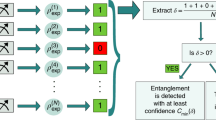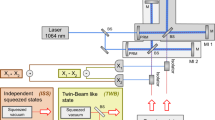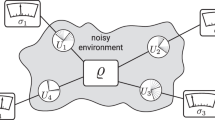Abstract
Historically, the completeness of quantum theory has been questioned using the concept of bipartite continuous-variable entanglement1. The non-classical correlations (entanglement) between the two subsystems imply that the observables of one subsystem are determined by the measurement choice on the other, regardless of the distance between the subsystems. Nowadays, continuous-variable entanglement is regarded as an essential resource, allowing for quantum enhanced measurement resolution2, the realization of quantum teleportation3,4,5 and quantum memories3,6, or the demonstration of the Einstein–Podolsky–Rosen paradox1,7,8,9. These applications rely on techniques to manipulate and detect coherences of quantum fields, the quadratures. Whereas in optics coherent homodyne detection10 of quadratures is a standard technique, for massive particles a corresponding method was missing. Here we report the realization of an atomic analogue to homodyne detection for the measurement of matter-wave quadratures. The application of this technique to a quantum state produced by spin-changing collisions in a Bose–Einstein condensate11,12 reveals continuous-variable entanglement, as well as the twin-atom character of the state13. Our results provide a rare example of continuous-variable entanglement of massive particles6,14. The direct detection of atomic quadratures has applications not only in experimental quantum atom optics, but also for the measurement of fields in many-body systems of massive particles15.
This is a preview of subscription content, access via your institution
Access options
Subscribe to this journal
Receive 51 print issues and online access
$199.00 per year
only $3.90 per issue
Buy this article
- Purchase on Springer Link
- Instant access to full article PDF
Prices may be subject to local taxes which are calculated during checkout




Similar content being viewed by others
References
Einstein, A., Podolsky, B. & Rosen, N. Can quantum-mechanical description of physical reality be considered complete? Phys. Rev. 47, 777–780 (1935)
Giovannetti, V., Lloyd, S. & Maccone, L. Quantum-enhanced measurements: beating the standard quantum limit. Science 306, 1330–1336 (2004)
Braunstein, S. L. & van Loock, P. Quantum information with continuous variables. Rev. Mod. Phys. 77, 513–577 (2005)
Braunstein, S. L. & Kimble, H. J. Teleportation of continuous quantum variables. Phys. Rev. Lett. 80, 869–872 (1998)
Opatrný, T. & Kurizki, G. Matter-wave entanglement and teleportation by molecular dissociation and collisions. Phys. Rev. Lett. 86, 3180–3183 (2001)
Hammerer, K., Sørensen, A. S. & Polzik, E. S. Quantum interface between light and atomic ensembles. Rev. Mod. Phys. 82, 1041–1093 (2010)
Reid, M. D. et al. The Einstein-Podolsky-Rosen paradox: from concepts to applications. Rev. Mod. Phys. 81, 1727–1751 (2009)
Ou, Z. Y., Pereira, S. F., Kimble, H. J. & Peng, K. C. Realization of the Einstein- Podolsky-Rosen paradox for continuous variables. Phys. Rev. Lett. 68, 3663–3666 (1992)
Reid, M. D. Demonstration of the Einstein-Podolsky-Rosen paradox using nondegenerate parametric amplification. Phys. Rev. A 40, 913–923 (1989)
Walls, D. & Milburn, G. Quantum Optics (Springer, 2008)
Duan, L.-M., Sørensen, A., Cirac, J. I. & Zoller, P. Squeezing and entanglement of atomic beams. Phys. Rev. Lett. 85, 3991–3994 (2000)
Pu, H. & Meystre, P. Creating macroscopic atomic Einstein-Podolsky-Rosen states from Bose-Einstein condensates. Phys. Rev. Lett. 85, 3987–3990 (2000)
Raymer, M. G., Funk, A. C., Sanders, B. C. & de Guise, H. Separability criterion for separate quantum systems. Phys. Rev. A 67, 052104 (2003)
Julsgaard, B., Kozhekin, A. & Polzik, E. S. Experimental long-lived entanglement of two macroscopic objects. Nature 413, 400–403 (2001)
Bloch, I., Dalibard, J. & Zwerger, W. Many-body physics with ultracold gases. Rev. Mod. Phys. 80, 885–964 (2008)
Leslie, S. R. et al. Amplification of fluctuations in a spinor Bose-Einstein condensate. Phys. Rev. A 79, 043631 (2009)
Klempt, C. et al. Parametric amplification of vacuum fluctuations in a spinor condensate. Phys. Rev. Lett. 104, 195303 (2010)
Chang, M.-S. et al. Observation of spinor dynamics in optically trapped 87Rb Bose-Einstein condensates. Phys. Rev. Lett. 92, 140403 (2004)
Schmaljohann, H. et al. Dynamics of F = 2 spinor Bose-Einstein condensates. Phys. Rev. Lett. 92, 040402 (2004)
Caves, C. M. & Schumaker, B. L. New formalism for two-photon quantum optics. I. Quadrature phases and squeezed states. Phys. Rev. A 31, 3068–3092 (1985)
Gross, C., Zibold, T., Nicklas, E., Estève, J. & Oberthaler, M. K. Nonlinear atom interferometer surpasses classical precision limit. Nature 464, 1165–1169 (2010)
Law, C., Pu, H. & Bigelow, N. Quantum spins mixing in spinor Bose-Einstein condensates. Phys. Rev. Lett. 81, 5257–5261 (1998)
Kronjäger, J., Becker, C., Navez, P., Bongs, K. & Sengstock, K. Magnetically tuned spin dynamics resonance. Phys. Rev. Lett. 97, 110404 (2006)
Gerbier, F., Widera, A., Fölling, S., Mandel, O. & Bloch, I. Resonant control of spin dynamics in ultracold quantum gases by microwave dressing. Phys. Rev. A 73, 041602 (2006)
Diener, R. B. & Ho, T. Quantum spin dynamics of spin-1 Bose gas. Preprint at 〈http://arXiv.org/abs/cond-mat/0608732v1〉 (2006)
Ferris, A. J., Olsen, M. K., Cavalcanti, E. G. & Davis, M. J. Detection of continuous variable entanglement without coherent local oscillators. Phys. Rev. A 78, 060104 (2008)
Jaskula, J.-C. et al. Sub-Poissonian number differences in four-wave mixing of matter waves. Phys. Rev. Lett. 105, 190402 (2010)
Bücker, R. et al. Twin-atom beams. Nature Phys. 7, 608–611 (2011)
Bookjans, E. M., Hamley, C. D. & Chapman, M. S. Strong quantum spin correlations observed in atomic spin mixing. Preprint at 〈http://arXiv.org/abs/1109.2185〉 (2011)
Lücke, B. et al. Twin matter waves for interferometry beyond the classical limit. Science doi:10.1126/science.1208798 (published online 13 October 2011)
Acknowledgements
We acknowledge discussions with P. Grangier, A. Aspect, A. J. Ferris, M. J. Davis and B. C. Sanders. This work was supported by the Forschergruppe FOR760, the Deutsche Forschungsgemeinschaft, the German–Israeli Foundation, the Heidelberg Center for Quantum Dynamics, Landesstiftung Baden-Württemberg, the ExtreMe Matter Institute and the European Commission Future and Emerging Technologies Open Scheme project MIDAS (Macroscopic Interference Devices for Atomic and Solid-State Systems). G.K. acknowledges support from the Humboldt-Meitner Award and the Deutsche-Israelische Projektgruppe (DIP).
Author information
Authors and Affiliations
Contributions
N.B.-G. and G.K. contributed to the formulation of the problem. C.G., H.S., E.N., T.Z. and M.K.O. contributed equally to the study. All authors discussed the results and commented on the manuscript.
Corresponding author
Ethics declarations
Competing interests
The authors declare no competing financial interests.
Supplementary information
Supplementary Information
The file contains Supplementary Text and Data, Supplementary Figures 1-2 with legends and additional references. (PDF 417 kb)
Rights and permissions
About this article
Cite this article
Gross, C., Strobel, H., Nicklas, E. et al. Atomic homodyne detection of continuous-variable entangled twin-atom states. Nature 480, 219–223 (2011). https://doi.org/10.1038/nature10654
Received:
Accepted:
Published:
Issue Date:
DOI: https://doi.org/10.1038/nature10654
This article is cited by
-
Time-of-flight quantum tomography of an atom in an optical tweezer
Nature Physics (2023)
-
Quantum field simulator for dynamics in curved spacetime
Nature (2022)
-
Multiparameter squeezing for optimal quantum enhancements in sensor networks
Nature Communications (2020)
-
Estimation of entanglement in bipartite systems directly from tomograms
Quantum Information Processing (2019)
-
Collective emission of matter-wave jets from driven Bose–Einstein condensates
Nature (2017)
Comments
By submitting a comment you agree to abide by our Terms and Community Guidelines. If you find something abusive or that does not comply with our terms or guidelines please flag it as inappropriate.



